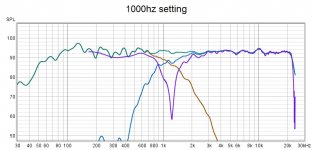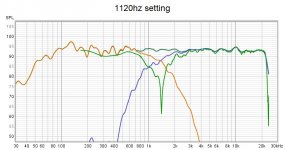Those are with a LR 4th order ... 2nd order looks the same BTW.
Used (2)peq's on the heil ... (1) to kill that 7.6khz peak (-5db) and another to bring up a dip around 13khz (+4db) and added a 12db (+2db) high shelf starting at 11khz to even up the top end a bit.
Used (2)peq's on the heil ... (1) to kill that 7.6khz peak (-5db) and another to bring up a dip around 13khz (+4db) and added a 12db (+2db) high shelf starting at 11khz to even up the top end a bit.
That's a 15PR400 .... their 15FH530 looks interesting, too. They didn't have that when I got the 15PR400 ... but I'm happy. 🙂
Flaxxer, this is probably too late now, but, if you're still browsing for something that fits your requirements, I'd check out GR Research
I've heard a couple of GR Research designs. Thank you for the recommendation.
Just so everyone knows ... I've chosen a pair of horn speakers to build. Maybe two pairs if the person that offered me their plans actually follows through.
I do NOT have a clue how I will get it done, but I've decided there will be a G1, 8" mid or dual 6" mids, and a 15" woofer design in my future. I'll probably end up paying someone to design it, IF I can't get it figured out. I was going to allow this forum to help me .... But this INNOCENT thread I posted had enough disagreements an arguments which went off track and off topic, I doubt I could ever actually get a design from it. Just too many ideas, and ways of skinning the beast.
Just so everyone knows ... I've chosen a pair of horn speakers to build. Maybe two pairs if the person that offered me their plans actually follows through.
I do NOT have a clue how I will get it done, but I've decided there will be a G1, 8" mid or dual 6" mids, and a 15" woofer design in my future. I'll probably end up paying someone to design it, IF I can't get it figured out. I was going to allow this forum to help me .... But this INNOCENT thread I posted had enough disagreements an arguments which went off track and off topic, I doubt I could ever actually get a design from it. Just too many ideas, and ways of skinning the beast.
Education please .... What is the deal with side firing woofers? WHY?
Is this to get a 15" or 18" woofer to fit the cabinet, without the baffle being too wide?
If not why would a person even do it, since it limits how high you can play it without directional issues?
Also, can someone explain what happens in regards to BSC, when there is a larger bass cabinet on bottom, then the mid/highs cabinet slims to only half it's width on top? Two different widths. Or does it only affect for a certain distance downwards which matters?
Is this to get a 15" or 18" woofer to fit the cabinet, without the baffle being too wide?
If not why would a person even do it, since it limits how high you can play it without directional issues?
Also, can someone explain what happens in regards to BSC, when there is a larger bass cabinet on bottom, then the mid/highs cabinet slims to only half it's width on top? Two different widths. Or does it only affect for a certain distance downwards which matters?
I guess main thing is to get big cone and have slim baffle with ease of construction. Wavelenghts are probably so long it doesnt matter which side the woofer is on.
Bafflestep simply means that long wavelenghts bend around the baffle edge to sides and back of the speaker. this means more of the sound power a transducer outputs at particular frequency radiates outside of the listening window. Now you have to increase power (EQ) to get the listening window amplitude up like it is with higher frequencies that radiate most of their power to the listening window due beaming or support of the baffle.
Now you think it is benefitical to increase baffle size to get more of the power to the listening window at low frequencies as well? Yeah, partly true but the bafflestep is due to diffraction and diffraction has ill effects so widening the baffle introduces worse interference on the listening window. If you think about it, acoustic design of the enclosure and drivers affect a lot on the output and waveguides and corner radiuses start to suddenly make sense.
In my view slim baffle is much better than wide, so big woofer is good on the side for easy construction and slim baffle. DSP can fix the bafflestep for each driver individually without extra cost so not much of a drawback. Doing it passively migh cost a lot. A good trade off. Narrow baffle is also about aesthetics, but in my view a valid engineering decision to keep the baffle narrow. It is all about wavelenghts 😉 and design trade offs.
Want two way, or amt, or passive xo or any particular technology just because of wanting it for no valid reason you'll paint yourself into a corner. If you keep the wavelenghts in mind and forget about desire for certain technologies or brands you are starting to get grasp how to build better loudspeakers simply by pushing trade offs outside from the audio (goal). Peace.
Bafflestep simply means that long wavelenghts bend around the baffle edge to sides and back of the speaker. this means more of the sound power a transducer outputs at particular frequency radiates outside of the listening window. Now you have to increase power (EQ) to get the listening window amplitude up like it is with higher frequencies that radiate most of their power to the listening window due beaming or support of the baffle.
Now you think it is benefitical to increase baffle size to get more of the power to the listening window at low frequencies as well? Yeah, partly true but the bafflestep is due to diffraction and diffraction has ill effects so widening the baffle introduces worse interference on the listening window. If you think about it, acoustic design of the enclosure and drivers affect a lot on the output and waveguides and corner radiuses start to suddenly make sense.
In my view slim baffle is much better than wide, so big woofer is good on the side for easy construction and slim baffle. DSP can fix the bafflestep for each driver individually without extra cost so not much of a drawback. Doing it passively migh cost a lot. A good trade off. Narrow baffle is also about aesthetics, but in my view a valid engineering decision to keep the baffle narrow. It is all about wavelenghts 😉 and design trade offs.
Want two way, or amt, or passive xo or any particular technology just because of wanting it for no valid reason you'll paint yourself into a corner. If you keep the wavelenghts in mind and forget about desire for certain technologies or brands you are starting to get grasp how to build better loudspeakers simply by pushing trade offs outside from the audio (goal). Peace.
Last edited:
I'll try to get something posted today. You might be surprised though.
Actually those measurements look too good, my comment pointed to your own phrase, but it seems that you have managed to overcome it.
Congratulations !
"At any rate, trying to shoehorn a 15" with the heil while trying to respect the "ideal" xo region will handcuff you. Don't get scared off of pushing the 15 "a bit higher in this combination."
Double Stack ESS AMT-1 with Wings--Possible Kit for Heritage - Technical/Modifications - The Klipsch Audio Community
You may be interested in this link.
Where would the lobes come from without the dips 😉
...
Loobing is any tiny deviation from uniform - this is marriner grave deep suckouts 🙂
//
Frequency graphs with 120dB vertical scale? 40-60 dB scale would be more suitable to judge loudspeaker performance.
..but I've decided there will be a G1..
Note: the G1 is extremely detailed, but doesn't have much mass to it vs it's surface area and has almost no resistance.
This (in the few designs I've heard with it), leaves it sounding a bit "thin" IMO.
IF you decide on this driver then consider a shallower crossover slope and a slightly higher high-pass (a bit above 2 kHz). This unfortunately requires more usable bandwidth from the midrange as a result, and very good off-axis performance (in other words a smaller diameter driver).
Also, some people have a problem with the vertical dispersion (even when listening on-axis). (..and while I have a problem with the verticals in the midrange for many MTM designs, ironically I personally don't have a problem with the tweeter's result - so it's very much person-dependent.)
Practically speaking then: a really good result with the G1 is likely to be a 4-way design with a small diameter driver(s) as upper midrange(s). (..this also means that integrating-in 8" or 6" mid-bass drivers becomes MUCH easier.)
Last edited:
Arrrgh! I will get it figured then. I will not leave my desire for a more esoteric HF choice.
But I am tired of back and forth. I will pull some trickery to use the TPL-150H, by using a rear firing super tweeter which is completely adjustable.
But I am tired of back and forth. I will pull some trickery to use the TPL-150H, by using a rear firing super tweeter which is completely adjustable.
So, I did surprise you. 🙂Actually those measurements look too good, ... snip
Noted ... I will adjust in the future.Frequency graphs with 120dB vertical scale? 40-60 dB scale would be more suitable to judge loudspeaker performance.
I agree with most of what you said, I think the video is a good demonstration of how the program material has a big influence on the amount of power that can be needed to prevent an amplifier from running out of headroom. I use R128 volume levelling myself and I could not go back to having to ride the volume fader myself anymore.In fact the whole demonstration is the inverse of what i talked about: monitor level is set at constant volume and the loudness difference between tracks is the native 'loudness' of the material.
Perhaps the graphs needed more explanation than I thought. Lobing is almost never a tiny deviation. The lobes form from destructive interference. The deep dips are caused by the path length differences and change depending on off axis angle. Within 15 degrees or so there is even response and if the off axis response was absorbed in room I can imagine it being no real problem other than a narrow sweet spot.Loobing is any tiny deviation from uniform - this is marriner grave deep suckouts 🙂
//
The scale of the DB / SPL graph, good point, and I would like to see a graph of the crossover network, more precisely the overlap in the middle zone .....
Have you used the twoofer of this link?
Loudspeaker Enclosure
(post 489) if not, tell us which one, because you cannot evaluate a graph without knowing which transducers you used.
The AMT is the original? If so, has the original diaphragm been replaced with new ones that are of different material and response? What is your FR and SPL?
Loudspeaker Enclosure
(post 489) if not, tell us which one, because you cannot evaluate a graph without knowing which transducers you used.
The AMT is the original? If so, has the original diaphragm been replaced with new ones that are of different material and response? What is your FR and SPL?
- Home
- Loudspeakers
- Multi-Way
- I'm building a $4000 speaker kit ... Which one?

